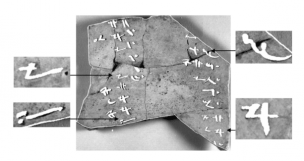The Dual Space: Concept and Applications in Cultural Heritage

An important question in cultural heritage concerns the make process of an artifact. Understanding the make process provides insight related to the origin, techniques, and craftsmanship used to make the artifact. Searching for tool marks or traces left by the artist’s hand is one way of retrieving clues related to the make process. X-ray computed tomography is a nondestructive tool that produces volumetric images of structures inside an artifact. However, interactively searching in large volumetric images for tool marks is a difficult, tedious, and time-consuming task. In this article, we introduce the concept of a dual space. The governing idea is that the dual space represents the air in the interior of an object. In the context of cultural heritage, the dual space represents those materials that first belonged to the object but have been removed during the make process. Our main goal of creating the dual space is to facilitate searching, inspection, and interpretation of tool marks. We provide two examples of how the dual space can be used to study the make process.





Related Articles

Computational Handwriting Analysis of Ancient Hebrew Inscriptions—A Survey
Ancient texts are unique evidence providing a glimpse into the thoughts, day-to-day life, and culture of people of long-gone eras. Paleography, the study of ...



Revealing and Reconstructing Hidden or Lost Features in Art Investigation
In recent decades, cultural heritage research—and in particular art investigation—has been undergoing a digital revolution. This is due both to improvements ...












Image Processing Perspectives of X-Ray Fluorescence Data in Cultural Heritage Sciences
X-ray fluorescence (XRF) analysis of art objects has rapidly gained popularity since the late 2000s due to its increased accessibility to scientists. This in...









